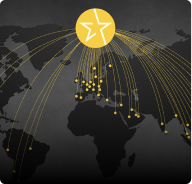
Motivating sales teams isn’t just about numbers—it’s about fostering a sense of recognition and appreciation. The question isn’t whether a sales incentive program is worth implementing but which method will best drive employees to excel.
Gift cards are tokens of gratitude that recognize employees’ efforts and empower them to choose rewards that resonate with their interests. This article explores why bulk gift cards are the ultimate sales incentive for motivating and acknowledging sales teams and how to pick the best provider for your company.
What makes bulk gift cards ideal for sales incentives?
Motivating sales teams is challenging for businesses of all sizes, yet essential for success and team morale. Since 2010, U.S. gift card sales have doubled, exceeding $200 billion in 2023. This growth reflects their increasing popularity and appeal. No wonder businesses use gift cards as incentives—the benefits are clear.
Serves as symbols of recognition
Regular income is routine and expected, providing financial stability but lacking excitement or special recognition. Gift cards stand out as an acknowledgment of exceptional performance, enhancing the recipient’s sense of accomplishment beyond their regular paycheck.
Flexibility and personalization
Partnering with a company that offers thousands of gift card brands empowers employees with autonomy similar to cash. They can select a gift card that matches their preferences and needs, making the reward more meaningful and enhancing overall satisfaction and engagement.
Cost-effective alternative to cash
Issuing bulk gift cards is a cost-effective alternative to cash bonuses. Companies can purchase gift cards in bulk at discounted rates, maximizing their budget and rewarding more employees without increasing total expenditure. This is particularly advantageous for businesses with tight budgets or those wanting to award employees frequently.
How do you decide which gift cards to pick?
For a sales incentive program to succeed, businesses must choose gift cards that resonate with employees. Consider the brands’ geographical reach: some have a global presence, ideal for multi-location enterprises. Others cater to local tastes and needs.
Discounts on bulk purchases also vary; selecting brands with better deals allows a company to stretch its incentive budget and reward more employees without increasing costs. Offering a variety of choices is vital, as employees highly value the freedom to select gift cards that match their preferences.
How do you pick a bulk gift card provider?
Extensive brand selection
Look for providers that offer a wide variety of brands. An ideal bulk gift card provider has access to thousands of brands, ensuring you cater to diverse employee wants.
Global accessibility
If your company operates internationally, choose a provider that supports global accessibility. This flexibility allows for a consistent incentive program across all locations, simplifying management and ensuring employees feel equally valued.
Simple integration and distribution
The ease of incorporating and distributing gift cards is crucial. Providers offering robust API support make integrating gift card distribution into your existing systems easy, minimizing administrative burdens and ensuring timely delivery of rewards.
Bulk savings
Investigate the discounts available on bulk purchases from different providers. Some may offer significant savings, allowing you to maximize your budget and honor more employees for small achievements.
Avoiding extra fees
Be aware of any potential service or partnership fees. The best providers offer transparent pricing without hidden costs, preserving the value of your incentive program.
How do you distribute and manage bulk gift cards effectively?
Effectively managing bulk gift cards requires meticulous planning. Define clear distribution criteria, segment your audience based on preferences, and schedule regular distributions to maintain motivation and engagement.
Integrate reward, HR, or payroll platforms with gift card providers via API to streamline distribution. This automation, triggered by events like meeting sales targets, saves time, reduces errors, and ensures timely benefit delivery. APIs also offer real-time tracking, facilitating prompt issue resolution.
Clear communication about the program’s mechanisms and expectations is crucial. Leaders should inform employees how and when they will receive their gift cards, establishing transparency.
How do you track and measure the success of gift card incentives?
Key performance indicators (KPIs) to measure success
Start by identifying KPIs that align with your incentive program goals. Measure changes in sales metrics, such as revenue, conversion rates, and average order value, to assess the impact on driving sales. Monitor employee engagement through surveys, feedback, or satisfaction scores to evaluate motivation and retention. Track customer satisfaction metrics, like Net Promoter Score (NPS) and retention rates, to see if incentives improve loyalty.
Companies should also consider other indicators—employee morale, turnover, and referral rates—for a comprehensive view of success.
Time frame for seeing results
Results from gift card incentives vary based on factors including program nature, industry, and goals. Immediate impacts, like sales improvements, may occur within weeks or months. Increased employee engagement or customer loyalty may need monitoring over quarters or years.
Importance of bulk gift card partner insights
Partner with a bulk gift card provider that offers insights and analytics. These providers deliver robust reporting capabilities and data analytics to track performance, identify trends, and make data-driven decisions to improve your incentive strategy continuously.
Conclusion: Partner with NeoCurrency to use bulk gift cards for sales incentives
In conclusion, this article emphasizes the importance of using bulk gift cards as incentives to motivate and honor sales teams effectively. It highlights how gift cards offer a tangible symbol of appreciation, provide flexibility and personalization, and are a cost-effective incentive solution.
Choosing the right gift cards and the provider is crucial. Consider brand selection, global accessibility, integration ease, and cost efficiency. Through effective distribution and management, constantly improve incentive programs and track success through KPIs.
With a global reach spanning over 120 countries, NeoCurrency provides cash-like payments accepted worldwide. Choose from our extensive selection of 2,000+ brands across more than 60 countries to personalize rewards for your team.
Ready to revamp your sales incentive program? Request a demo today and discover how NeoCurrency revolutionizes your approach with bulk gift cards!




